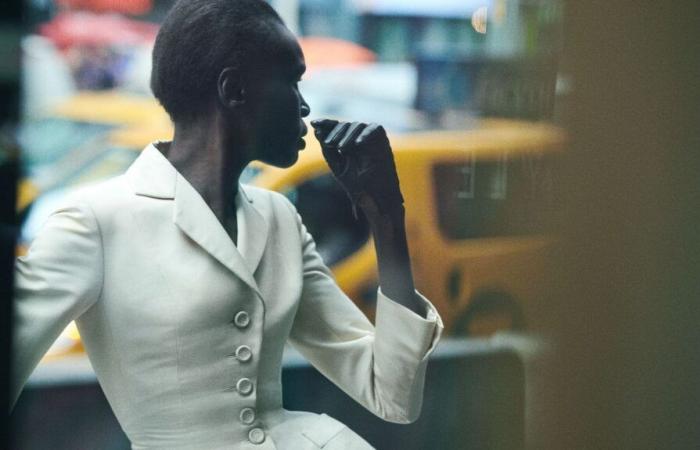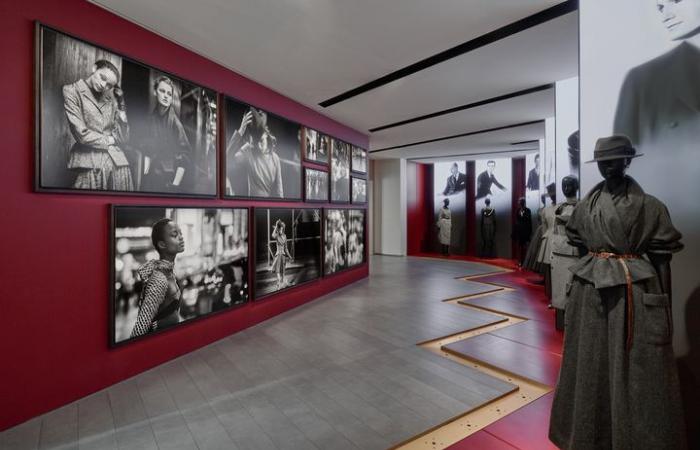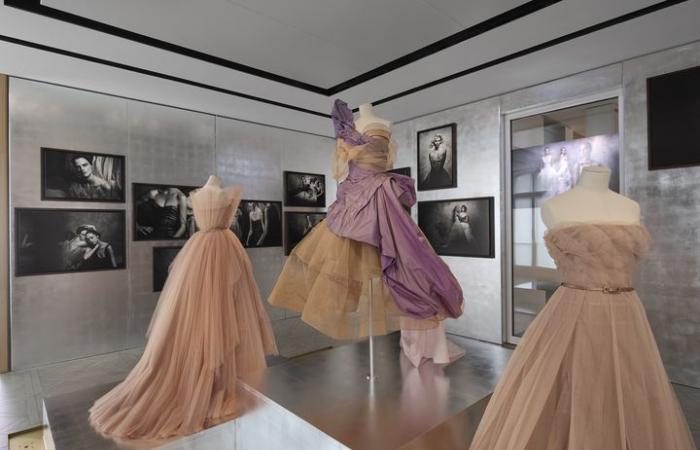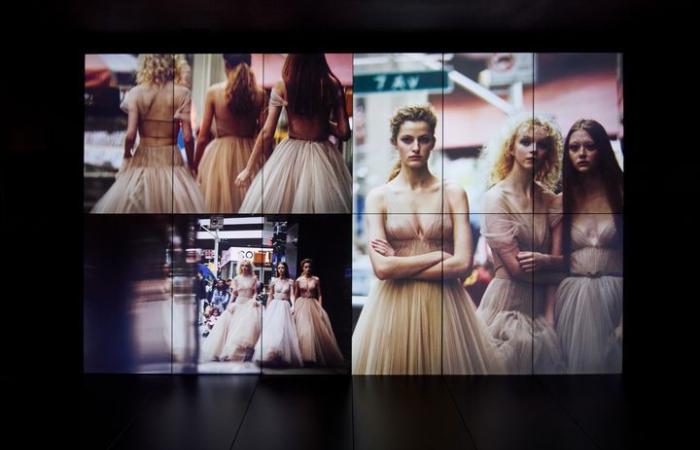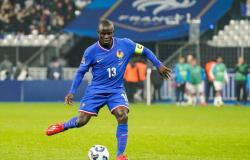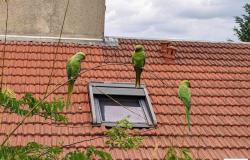Until May 4, 2025, the new rotation of the Dior Avenue Gallery Montaigne, in Paris, pays homage to one of the greatest fashion photographers of the second half of the 20th century and the beginning of the 21st century, Peter Lindbergh. Designed with the support of its foundation and deployed within the gallery spaces, this retrospective reveals photographs from legendary series, contact sheets, previously unpublished reading prints and, for the first time, the photo shoot carried out in the streets of New York, at Time Square, in 2018.
And spiral staircase in the center of the diorama – atrium presenting 1,874 Dior objects in miniature version, including 450 mini-dresses, based on historical models and available in the colors of the rainbow – marks the starting point of the exhibition Dior/Lindbergh, the sixth since the opening of the place in 2022. The director of the gallery, Olivier Flaviano, was our inexhaustible guide.
Franceinfo culture: Is this the first time that so much space has been dedicated to an artist?
Olivier Flaviano, director of the Dior gallery: This is the first time that we have created, in fact, a double story: telling that of Dior over seventy years of existence through the eye of Peter Lindbergh. For this last major project on which he worked, the photographer features eighty haute couture models signed Christian Dior and his successors – Yves Saint Laurent, Marc Bohan, Gianfranco Ferré, John Galliano, Raf Simons and Maria Grazia Chiuri – at New York. In the exhibition, we highlight two types of photos: those for magazines and those produced for Dior, in particular for this order made in October 2018 for a book published at the end of 2019, after his death.
We present 109 prints from 1988 to 2018, exhibition prints from 2024 made from the file validated by the photographer and his printer. We were able to borrow works, contact sheets, study prints, images, documents never shown at his foundation to reveal his creative process. Almost all of them we know from magazines and books but they had never been printed on a large scale for an exhibition.
In the hall, the first photograph shows an iconic model from the designer’s first collection.
Yes, it’s an image from 2018 in New York with Alec Wek wearing the Bar suit from 1947. For this shoot, Peter Lindbergh brought in models who wore Dior in the 1990s. This image, quite strong, shows how we manage to create a dialogue between the past and the present, and that’s a bit of what we always try to reveal in our exhibitions.
The first room is devoted to the history of Christian Dior and this Bar suit.
We wanted to show the modernity of this garment in today’s life: we go from 1947, Monsieur Dior’s first collection, to 2017, Maria Grazia Chuiri’s first collections, to create a link between the two. It’s a journey through time using black and white images from October 2018.
For Peter Lindbergh, the suit is the Parisian essence and the latter can be reinvented seventy years later with photography which is never only an object of representation but also a mirror of our societies. This is also what Maria Grazia Chuiri said when she arrived in 2016: fashion reveals the aspirations of our time.
“Dior / Lindbergh” exhibition at La Galerie Dior in Paris
“Dior / Lindbergh” exhibition at La Galerie Dior in Paris
(“Dior / Lindbergh” exhibition at La Galerie Dior in Paris)
In the 2nd room, head to the enchanted gardens of Monsieur Dior, who had a passion for flowers since his childhood. Having become a fashion designer, he drew his inspiration from nature, making the silhouette of a flower woman flourish from his first fashion show in 1947.
In the middle of the silhouettes presented, we created punctuations with images of Peter Lindbergh. There are, for example, two pretty incredible images from John Galliano’s first haute couture collection from Spring/Summer 1997. Usually accustomed to black and white, he photographed them in color, in his studio. It’s a studio setting, like a painter’s studio, because these dresses reminded him of paintings.
You should know that Peter Lindbergh has aesthetic ghosts – cinema with film Metropolis by Fritz Lang in 1927 and dance with Pina Beauch in 1973 – which inspire him with stories like, for example, these two photographs where he suggests movement.
The visit continues in the room dedicated to the Dior look, which allows you to see how this silhouette is reinterpreted over time.
Yes, facing a clothing model from each of the house’s artistic directors are large black and white prints that bring these models back to life. For the photographer, black and white allows you to concentrate on the subject – the color does not disturb the eye – and reveal it in its truth.
He was very inspired by the documentary photography of the years 1930/1940, – like Dorothea Lange who photographed the depression in the United StatesUnited in high contrast blacks and whites adding drama to the image – just like images he saw in magazines during his childhood in the years 1940/1950. It is with these references in mind that he photographs – sixty years later in New York – these models in shades of black, white and gray. We must not forget that when Christian Dior created a collection, he made a pencil sketch : he first thought of it in black and white like an architect, he who had wanted to be one !

We pass in front of the office and the cabin, before arriving at the room dedicated to the archives from the series he produced for Vogue, Harper’s Bazaar, The World.
It allows us to return to what Peter Lindbergh brought to the history of photography. He is known in particular for these photos which embodied the birth of the top models (Linda Evangelista, Amber Valetta, Cindy Crawford, Naomi Campbel) like this 1988 commission for the Vogue American from a series on the beach of Santa Monica where he photographs them in large men’s shirts. The series will not be published but a few weeks later, Anna Wintour – who has just been named – discovers her and asks her to do her first cover. The model then wears a Lacroix embroidered top over denim, a very modern mix of style.
It is also in 1988 for the Vogue Paris in September, he photographed Linda Evangelista in a little black dress by Marc Bohan at the counter of a Parisian bar. What characterizes her work is her way of revealing women in their beauty but also in their fragility and simplicity. He has a very naturalistic vision. It is an image of a natural woman who expresses her emancipation, her freedom through the way she dresses and presents herself.
We should also not miss these archival documents, archival works, which usually never leave the Peter Lindbergh Foundation and which they were kind enough to lend us. You have the conservation boxes for each of the shootings and inside the contact sheets, the reading prints, sometimes with small polaroids with their annotations. Peter Lindbergh looked at all the contact sheets and decided everything : thus the crosses on the images designate the destination support – fashion magazine, exhibition, book. In the archive boxes, there are sometimes storyboards that he wrote with a story and a drawing. This narration in the image, we see it in 1990, in a series for Vogue Italy where Elena Christensen meets an alien in the desert.
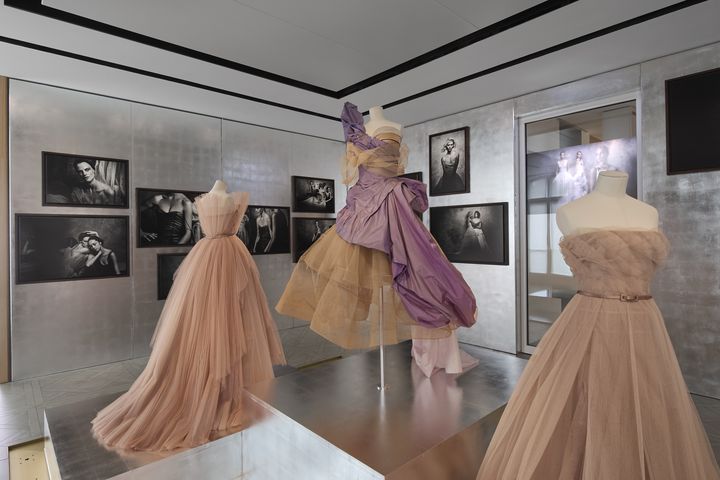

What are the particularities of these other photographs from the 2018 shooting taken in the studio?
In the next room, we find photos of the most fragile dresses, those in silk, long dresses shot in the studio. With, for example, the Victoire dress by John Galliano from fall-winter 2005. It is an important year, that of the centenary of the birth of Mr. Dior. In this collection, there were dresses that revealed a model in the process of being : you see a little padding, tulle, as if we were still in the workshop with this fabric effect which drapes the model.
Opposite these models, extremely contrasting black and white photos : this gives a more dramatic side to the images and reinforces the idea of the intimacy of the studio. Peter Lindbergh profoundly changed the image of women in magazines by putting them at the center of their photos so that they could reveal their beauty through their naturalness and fragility. He said : “The responsibility of photographers is to free women from the dictatorship of youth and perfection.”
Paris – where haute couture was born in the second half of the 19th century – is a source of inspiration for Monsieur Dior as shown in the room of the little black dress, the essence of the Parisienne.
Next to the black dresses presented here, we have inserted a fairly iconic photograph : this is an advertisement produced in 2009 for a Lady bag campaign Dior with Marion Cotillard photographed on the Eiffel Tower. It’s an extremely Parisian image !
The last room returns again to this crazy project of “street photography” whose specificity is to capture the spontaneity of the moment and where the silhouettes take shape in the movement of life to use the words of the couturier.
What interested Peter Lindbergh was playing on contrasts : temporal contrast (70 years of Dior in 80 models), contrast in the image (different generations of models, some of which came specifically), geographical contrast (dresses designed in Paris and projected onto the streets of New York). The good thing is that this photo shoot was filmed and therefore we also show life and movements with this wonderful video.
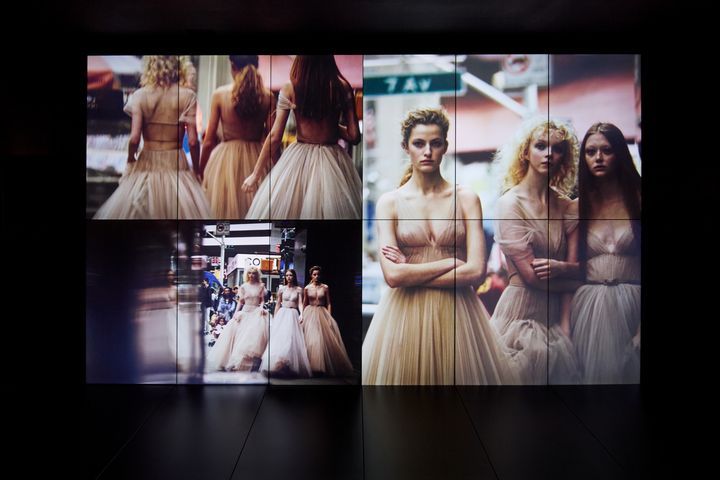

Right next to it, his cameras – which were used for this shooting and were kept by its foundation – as well as images which exude great joy where we see the photographer with models. All his work was to reveal the humanity of the models he photographed. Jean Cocteau said : “Whatever we do, we always create our own portrait and somewhere through all our images of women the very humanity of the photographer is revealed..”
Exposition Dior/Lindbergh until May 4, 2025. Reserving a time slot is recommended on the site galeriedior.com(New window) (11 rue François 1er, 75008 Paris). The gallery is open every day, except Tuesday, from 11 a.m. to 7 p.m.

